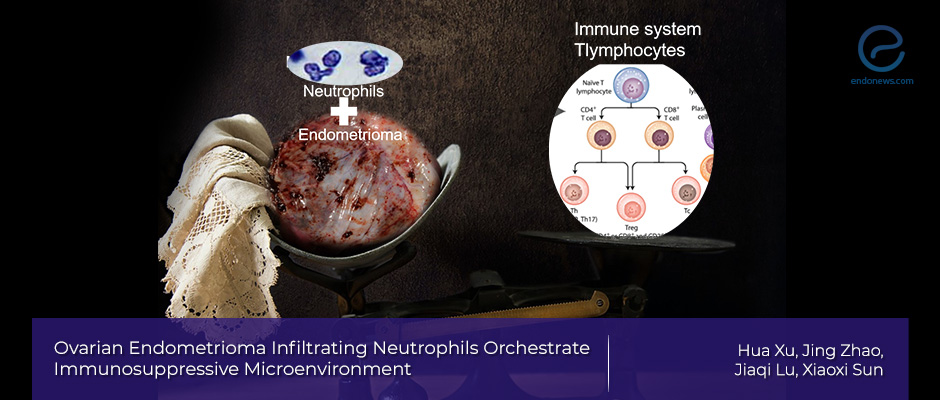White blood cell neutrophils link to immunosuppressive environment in ovarian endometrioma
May 27, 2020
Neutrophils orchestra in ovarian endometrioma
Key Points
Highlight:
- Neutrophils contribute to the progression of ovarian endometrioma by coordinating an immunosuppressive microenvironment through the immune checkpoint axis.
Importance:
- The relationship between neutrophils and the pathogenesis of endometriosis is known, however, the mechanisms by which neutrophils act to promote the growth of endometriotic lesion are not well understood.
What has been done:
This study investigates the role of neutrophils in regulating immunosuppressive microenvironment in ovarian endometrioma.
- Endometriotic tissue was obtained from 56 women with ovarian endometrioma. The tissues were divided into two cohorts, one (n=35) was analyzed using immunohistochemistry, and the other (n = 21) by flow cytometry.
- Neutrophils were detected using CD66b staining, and the expression of other immune checkpoint proteins, PD1, CD8, TIM3, CTLA4, IFN-γ, and CD45 were also examined.
- Correlations were then determined between their expression levels.
- Ovarian endometrioma conditional supernatant (OECS) was prepared and used to test its effect on neutrophil survival, PD-L1 expression on neutrophils, T cell proliferation, and function.
Results:
- There is a positive correlation between neutrophils count and the severity of ovarian endometrioma.
- Neutrophils were positively correlated with PD1+, TIM3+ and CTLA4+ CD8 T-cells in ovarian endometrioma.
- OECS increased neutrophils’ survival, PD-L1 expression, and reduced proliferation and activity of autologous T cells.
Limitation:
- This study is limited by the lack of study on healthy ovarian tissues. Therefore, it is difficult to understand if the observation was specific to endometriosis.
Lay Summary
Recently the contribution of neutrophils to the pathogenesis of endometriosis has been suggested. Several observations fuelled this suggestion, such as the accumulation of neutrophils in the peritoneal fluid of ovarian endometriosis; neutrophil extracellular traps were found in the peritoneal fluid of endometriosis patients; neutrophil regulation of cyclical endometrial vascular proliferation in human endometrium and neutrophil depletion reduced the severity of endometriotic lesions.
So what are neutrophils? Neutrophils are white blood cells that form the first line of immune defense against microbial infections. Thus, these cells have a fundamental role in inflammatory disease. Despite the tell-tale sign, current understanding about how neutrophils promote endometriosis progression is not well defined.
Xu and co-investigators from the Obstetrics and Gynecology Hospital, Fudan University, Shanghai investigated the role of neutrophils to mediate immunosuppressive microenvironment in ovarian endometrioma. The study results were recently published in the "Journal of Ovarian Research".
The project collected endometriotic tissue specimens from 56 women with ovarian endometrioma who underwent laparoscopic surgery. The specimens were separated into two cohorts, cohort one consisting of 35 patients to analyze thorough immunohistochemistry, and Cohort 2 consisting of 21 patients via flow cytometry. Neutrophils in the specimens were identified using CD66b staining, and the expression of other immune checkpoint regulator proteins such as PD1, CD8, TIM3, CTLA4, IFN-γ, and CD45 was also examined. The role of neutrophils in immunosuppression was then inferred by correlation with these immune checkpoint regulators tested.
The effect of ovarian endometrioma conditional supernatant was also studied, specifically, its effect on neutrophil survival and the ability to attenuate CD8+ T-cell proliferation and activity was assessed.
The data showed that neutrophil count was associated with the severity of endometriosis. Furthermore, there were significant positive correlations between the levels of neutrophils and PD1+, Tim3+, and CTLA4+ expression on CD8+ T cells. Endometrioma conditional supernatant stimulated neutrophils and their PD-L1 expression while suppressing T-cell proliferation and activity.
Overall these data indicate that PD-L1 expression on neutrophils may contribute to the immunosuppressive microenvironment responsible for the progression of ovarian endometrioma. Though the study is limited by a small number of women and the lack of comparison to the normal cohort, this study nonetheless suggests that neutrophils contribute to endometriosis progression via reducing immune response through the immune inhibitory checkpoint axis.
Research Source: https://pubmed.ncbi.nlm.nih.gov/32334621/
immune system inflammation PD-1 PD-L1 checkpoint endometrioma chocolate cyst immune suppression

